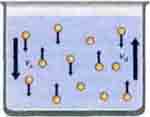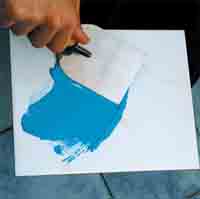Building mixture
Building mixturecan be lime, clay, clay-lime, lime-gypsolite and clay-cement. Before you add the clay in mixture, it is necessary to pre-soften and pass through a dense sieve
Building mixture should be absolutely uniform, to impossible to distinguish individual ingredients in it. This is achieved by continuous stirring with a suitable tool. Critical for building mixture is a quantitative ratio of the components. It depends on the purpose of the mixture (masonry, plaster, sealing cracks, etc.).
With more binder building mixture is 'fat'. Plaster from this solution has cracks when drying.
With an excess of filler (sand) get not fat mixture, giving a weak, fragile plaster.
If when mixing the solution strongly sticks to the tool - it is 'fat', if not stick - not fat, normal mixture should be sticking to the tool slightly.
Preparation of lime building mixture
Preparation of lime building mixture get as: sand evenly poured on a solid surface and cover the necessary amount of lime. The mixture is shoveled a few times, then carefully mix with a hoe. In the middle do the crater, into which is poured water. The mixture is again stirred so that the crater gradually filled with the mixture, and the edges were constantly above the mixture to avoid overflow. The ready mixrute must be a sufficiently dense homogeneous mixture.Preparation of a clay mixture
The clay mixture can be used for masonry and plaster only in auxiliary and secondary buildings. This solution is prepared as lime, but it is weaker than lime. To increase strength the hydrated lime (gypsum or cement) added in the clay mixture. For clay-lime mixture to one part clay take 0,3...0,4 parts of hydrated lime and 3...6 parts of sand. The amount of sand depends on the function of the mixture (masonry, plaster). For preparation of clay-plaster mixture to one part clay take 0.25 parts of gypsum and 3...5 parts of sand. To clay-cement mixture needs a one part clay, 0.15...0.2 part of cement and 3 ... 5 parts of sand.Composition of the cement
Cement is the main material for construction. The composition of cement is a mixture of limestone and clay. The mixture is subjected to sintering and the sintered mass is milled and get a grey powder consisting of CaO, Al2O3 and SiO2. If this mixture mix with water, then the mass hardens. If added sand to cement, then concrete is produced. If armature inside in concrete products - skeleton of steel rods or mesh, then got very durable material - ferroconcrete.Unlike other binders (lime, plaster, sand, liquid glass) it may continue to harden after mixing with water and pre-curing in air. It is resistant to water in the solid state.
Required 24...28% water to do the cement paste. Deviation both downward and upward lower quality of cement.
Grappling cement occurs one hour after mixing it with water and stops when hardening the mass loses its plasticity - usually after 12 h.The higher the temperature, the faster cement setting. So in the summer the cement hardens faster. The process can be accelerated by using various additives.
How to destroy hardened cement.
Hardened cement (cement stone) is destroyed soft water, containing carbonic acid, acidic waters (discharges of industrial production), water containing sulphates and chlorides (seawater).
Preparation of cement mixture
With necessary quantity of sand do a pile, then add cement and use shovel to do a uniform mixture. It lay in a thick layer and pour the necessary quantity of water, then stirred to obtain a homogeneous mixture, which should be used in the next hour!
Cement mixtute when the ratio of cement and sand 1:4 or 1:5 - difficult to apply on the wall and does not stick. For this purpose use enriched cement mixture (1:2 or 1:3). High quality elastic mixtures are prepared from cement, lime and sand. To prepare this mixture dry cement is mixed with sand. Slaked lime is diluted to a viscosity sour cream and pour in it a mixture of cement and sand, and then stirred well until get a homogeneous mass.
The preparation of concrete
An important condition for concrete preparation is a good mixing of the components of mixture - of cement, sand and water. Therefore, concrete mix to be a better cook in the mixer. In small quantities, concrete mix do it manually. Gravel is poured on solid ground a pile height of 10...15 cm, evenly covered with cement and use shovel to obtain a dry homogeneous mixture. Then again form a pile with a crater, which with constant stirring, add water to obtain a thick mixture. The rates of consumption of cement and sand following:
- for 1 m2 concrete thickness of 5 cm - 13.6 kg of cement and 6 buckets of sand
- for 1 m2 concrete thickness of 8 cm - 21.8 kg of cement and 9 buckets of sand
- for 1 m2 cement putty thickness of 2 cm - 11.3 kg of cement and 2 buckets of sand
- for 1 m2 cement putty thickness of 3 cm - 16,5 kg of cement and 3 buckets of sand
Quantity of filled water depends on the humidity and type of sand. To prepare 1 m3 of concrete is consumed by approximately 200...250 l of water. The volumetric ratio of sand and gravel also depends on the type of sand. For natural sand - 0.6:1 ... 0.8:1, for clay 0.8:1 ... 1:1, for the perlite to 0.6:1.
For proper curing concrete mix after filling in the initial period of "gripping" it must be protected from rapid drying, impact shock, abrasion and cold.
Keeping the concrete wet during curing is essential to achieve the design strength. The surface begin to pour with water immediately after establishing that it is not damaged by water (24 hours after the getting concrete) .
At temperatures above +50C surface watered within 7 days, but below +50C - not watered, and take action against the drying of the concrete, closing it with wetted material (sand, cloth, etc.) or freshly poured concrete covered with a waterproof cover. The strength of the mixtures prepared from sludge of processing plants, is higher than from pit sand.

Ñolloidal mixture

The foam. Manufacturer of foam
Chemical reaction. Types of chemical reactions
Resin. Phenol-formaldehyde resin
Ammonia. Properties of ammonia
Bases. Properties of bases. Alkali
Enzymes. The action of enzymes